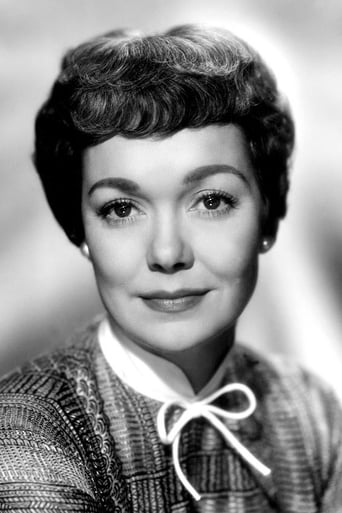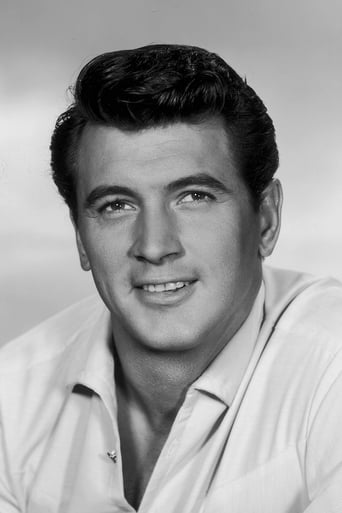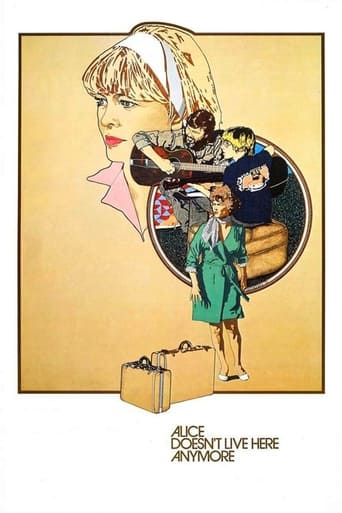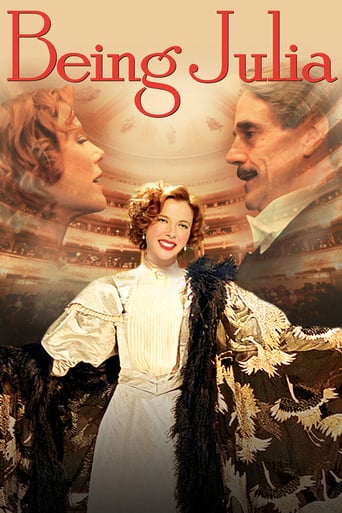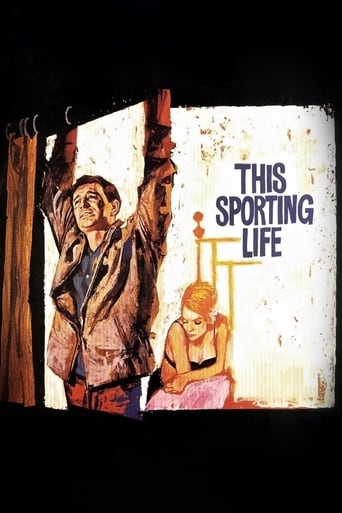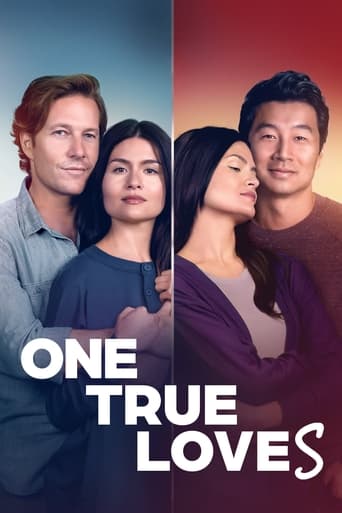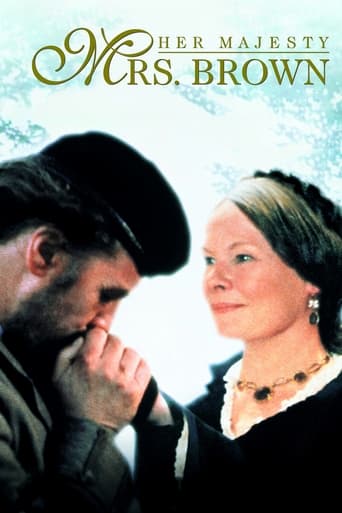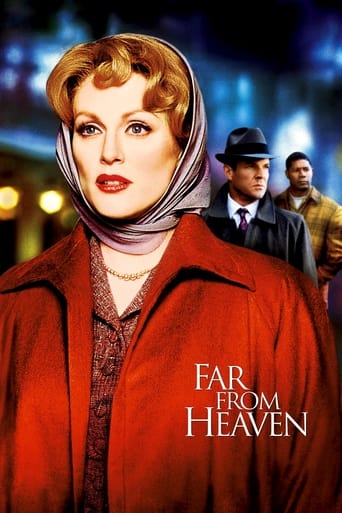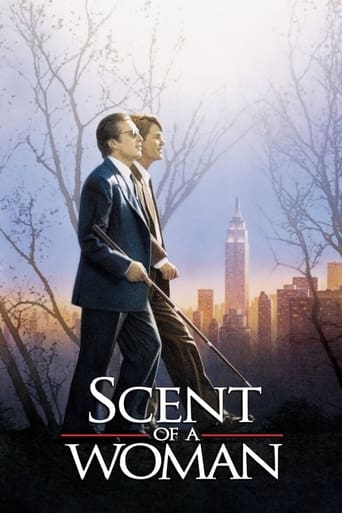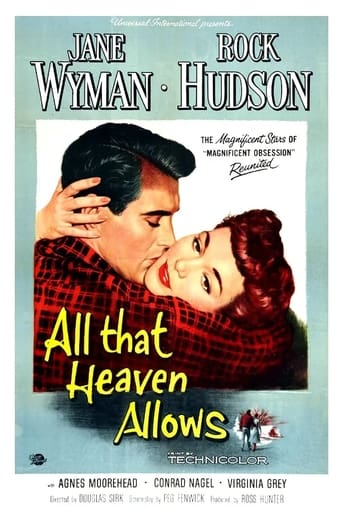
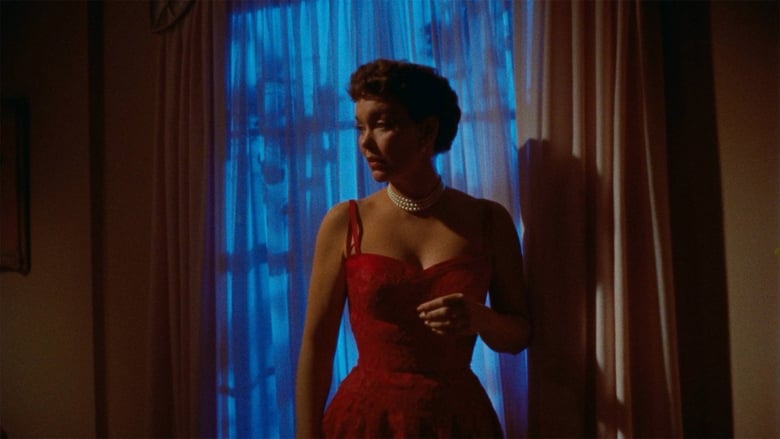
All That Heaven Allows (1955)
Two different social classes collide when Cary Scott, a wealthy upper-class widow, falls in love with her much younger and down-to-earth gardener, prompting disapproval and criticism from her children and country club friends.
Watch Trailer
Cast


Similar titles
Reviews
'All That Heaven Allows' is the first Douglas Sirk film that I have ever seen and it only took me one viewing of this film to see how much of a master technician Sirk was. This film is a social commentary on the fickle nature and the hypocrisy of life in the suburban small towns of post war 1950s America. But Sirk critiques this society not just with the story, but also with his visuals.The film starts with the camera suspended in the air close to the tower clock of the town. Slowly the camera pans sideways to show us this supposedly idealistic version of the perfect American suburban locality. Similar to Joseph L. Mankiewicz's 'A Letter to Three Wives', 'All That Heaven Allows' explores the grim reality of the 'happy' life in post WW2 suburban America. This society is enveloped by a suffocating law of conformity. One is supposed to know his/her role and carry it out accordingly. This film shows the rigid hypocrisy that lied underneath the ideal exterior of this society which made life hell for some people and especially women. Cary, our protagonist is a widow. So she has to accept the fact that she can't have fun anymore and will have to restrict her life to what's on television and somewhat wither away. If she tries to defy these conventions and give love another chance by falling in love with a younger man, she will be on the receiving end of judgement. The way Cary's kids Ned and Kay behave actually adds a layer of complexity to the story. They are also trapped in this rigid, non-liberal society(although Kay thinks otherwise), however they don't feel the need to change. They will approve of it if their mother remarries and the new husband is nothing but a duplicate of their father and stands for everything that he stood for, but they will not accept it if Cary's lover turns out to be a younger, more liberal individual who is different to their father. The character of Ron represents the change that was on the verge of taking place in American society. He is the type of person who would have been called a hippie only about a decade later. What makes this film a masterpiece is the direction of the film and style of storytelling, more than the story. Sirk utilises technicolor in the most artistic way. The film looks vibrant. There are shots that are so beautiful to look at that they can be easily framed and hung on the wall. Sirk uses a harsh blue artificial light in the film to signify the ominous and constant presence of societal judgements and oppression. The blue light keeps appearing in the film to riddle Cary with doubts and hesitations. Red is used as the colour that signifies a sense of happiness and freedom. Sirk plays around with these and other colours quite immensely. This incessant use of vibrant colours can be easily seen as an influence on Rainer Werner Fassbinder's films. His 'Ali:Fear Eats the Soul' is a bit of a tangential remake of 'All That Heaven Allows'. There are also a number of different techniques used in 'All That Heaven Allows' to visually give the impression of characters trapped in a particular frame. Sirk uses the reflective nature of mirrors or the reflection of a character on the limited space of a television screen or in other cases window bars and grills to show characters trapped in a thematic sense in this uptight suffocating societal prison. The precise and meticulous blocking of actors is also used extensively to visually express certain changes in themes or tones.Jane Wyman gives a performance which is layered and complex. She uses her facial expressions a lot to signify a change in her mood. It is not possible for the viewer to not care for her and her plight. Rock Hudson exudes masculine charm and appeal. He is handsome, charismatic and has a commanding gentlemanly presence which makes it quite believable that Cary will be smitten by Hudson's character Ron and want to be with him.Yes an argument can be made that certain convenient adjustments are made in the screenplay to arrive at an ending which would have been acceptable for the audience of the time, but personally I didn't have a problem with these adjustments because of the way Sirk kept using artistic visual flair to execute them. This is genuinely a masterpiece rich with feelings, emotions, social commentary and visual artistry. An absolute must-watch.
Director Douglas Sirk takes a story by the obscure writing team of Edna and Harry Lee, puts it together with two big stars in Jane Wyman and Rock Hudson, and emerges with a first-rate critique of the class prejudices and soul-crushing expectations in Country Club America. There aren't many surprises along the way, really, but the thing doesn't just sit there either.... if we, the audience, are allowed to come up for air, then we would lose some of our identification with the superficially "unimportant" tribulations of the heroine, Cary (Wyman). As for Hudson's character (Ron), he doesn't just read, but lives, Thoreau... yes, a character in the movie actually says that. Let's not pretend the movie is any more subtle than any of Sirk's other work.We could pick it apart for all its "unreality", but in my opinion the film was never designed to be real. It's a sort of expressionist take on American culture, one which Sirk would follow up with even more broad strokes on the subject in following years. I do think that the film's discussion on class division would have more weight if, for example, Ron's supposedly rustic hideaway didn't look like something out of Woman's Home Companion's winter guidebook. The Ron Kirby character is a bit too far out of the realm of reality, perhaps because his persona had to be twisted in such a way to make him totally acceptable to the types of people in the audience who might, in their day to day lives, represent the characters in the film who reject him on social grounds. So, it's all very harmless, and when we meet Ron's working class friends they come complete with the friendly Greek fisherman, bird-watching old lady, etc. One wonders what the effect would have been, for example, if one of Marlon Brando's early 50s characters had walked through the door.But again, let's never mind "reality", and let Sirk have his own little pretensions. My main real criticism along those lines is that the film did not show any kind of social pressure coming from Ron's friends against his settling with Cary. Indeed, Ron's best friends (played by Virginia Grey and William Reynolds) are practically gurus of philosophy and tolerance. In actuality, it is not just the rich who perpetuate class division in America. Not to mention, the fact that she was obviously approaching 40 and already had children would have made her an unacceptable wife to many of his young friends, or so we might imagine. The film steers clear of any such criticism and as a result it's take on class (and age-ism) in America is lop-sided.The most cunning and memorable shot in the film is, of course, the one with the TV set turned into a mirror of Cary's loneliness, after she has succumbed to social/family pressure and ended her relationship with Ron. It deserves praise, but Sirk does not just fashion memorable images, but convincing scenes: often, from the most conventional and predictable situations. For example, the big party thrown by Cary's friend Sara (a fire-redhead Agnes Moorehead) -- everything about the scene is already known to the audience; we've seen it in a dozen films. What makes this one memorable is the depth of sleaze to which Donald Curtis' character descends, and his drunken self-conviction. Cary was a tramp all along, he figures, and it's his male prerogative to assume that he can now take her whenever he pleases. As Ron and Cary leave, we hear a voice from amongst the crowd telling us that poor Harvey (Curtis) was fortunate to survive an encounter with such a beast as Ron! It's a better film than it deserves to be, and credit can go to a very solid cast being directed with purpose and intelligence by Sirk.
It might not be a masterpiece of visual storytelling - most of it comes from plot and acting - but emotionally it's top notch, especially in the second half the film gains a seemingly unstoppable momentum. This being said it's certainly a nice-looking film with vibrant colors and surprisingly much shadow work that in films from this period one usually only sees in film noirs (which most of the time were in black and white). But one memorable visual cue is Cary's (Jane Wyman) reflection in the TV set (a gift from her children) which is effectively used as it traps her into a box and recalls what Cary's daughter said earlier about wives in Ancient Egypt getting put into a tomb together with their deceased husbands. Funnily in RWF's 'Ali: Fear Eats the Soul' the son kicks in the mother's TV set when she introduces the children to the man she intends to marry.Amidst all the melodrama there also is much humor, even up to the last frame with the deer in the window, though none of it suggested to me that Sirk was just a hipster who never actually meant anything what he put on screen, he just keeps things humorous, so I thought the giggles in the theater were mostly justified.Sirk, who made melodramas for Universal, where most films of its ilk eventually could probably be seen as confirming to consumerism and generally to what might be called the "American way of life", didn't subscribe to those things. Ron Kirby (Rock Hudson) is an outsider who found his own way in 50's America and Cary eventually follows him, mostly for his sake, but she is attracted to his way of life as well. Not to mention that most of Cary's friends and her children are pretty much exemplary Americans in theory, yet what shines the brightest in the film is their ignorance, their selfishness, and their compulsion to follow the herd by reacting the way they think they are supposed to react out of fear not to fit in. Those are probably not the first things one thinks of when one is invested in the romance that concludes with an emotionally satisfying happy ending. I'm not sure that this makes Sirk's work a prime example of subversive cinema, but likely a prime example of subversive works produced within the studio system.When Cary picked up Henry David Thoreau's book Walden my eyes almost fell out of my skull, just two days ago 'Upstream Color' brought the book to my attention and now again it was an important part of a film that again didn't fail to quote from it.I liked most of what I have seen from Sirk and I wouldn't say that 'All That Heaven Allows' is necessarily his crowning achievement but I had nothing to complain about and it's certainly up there with his best work, it sure is an excellent film and representative of Sirk's oeuvre at large.
Come on...."All that heaven allows" was cheesy in 1955 and its cheesy now.The difference is, cheesy is regarded as cool in 2012 in a post - modern - ironic kinda way;but that doesn't change the fact that it is and always will be an overheated melodramatic piece of kitsch with very little to commend it. How Douglas Sirk's admirers have conned critics into considering him as a major auteur is beyond me.But I guess if you stand on a street corner and shout long enough that the moon is made of cream cheese somebody is going to believe you. We have a Lady Chatterley thing going here with Mr R.Hudson as the gardener becoming involved with the socially superior Miss J.Wyman. When they decide to marry, her children - a twenty going on fifty five boy and a girl who makes a lot of speeches but absolutely no sense - strongly disapprove,as do her friends. She dumps the young Rock so hastily it almost seems rude,but,as you know,love will find a way - and it does,but not before he falls down a cliff.Don't ask. So there you have it.And I read that this film is in the Library of Congress.It's almost enough to make me want to withdraw my subscription.


